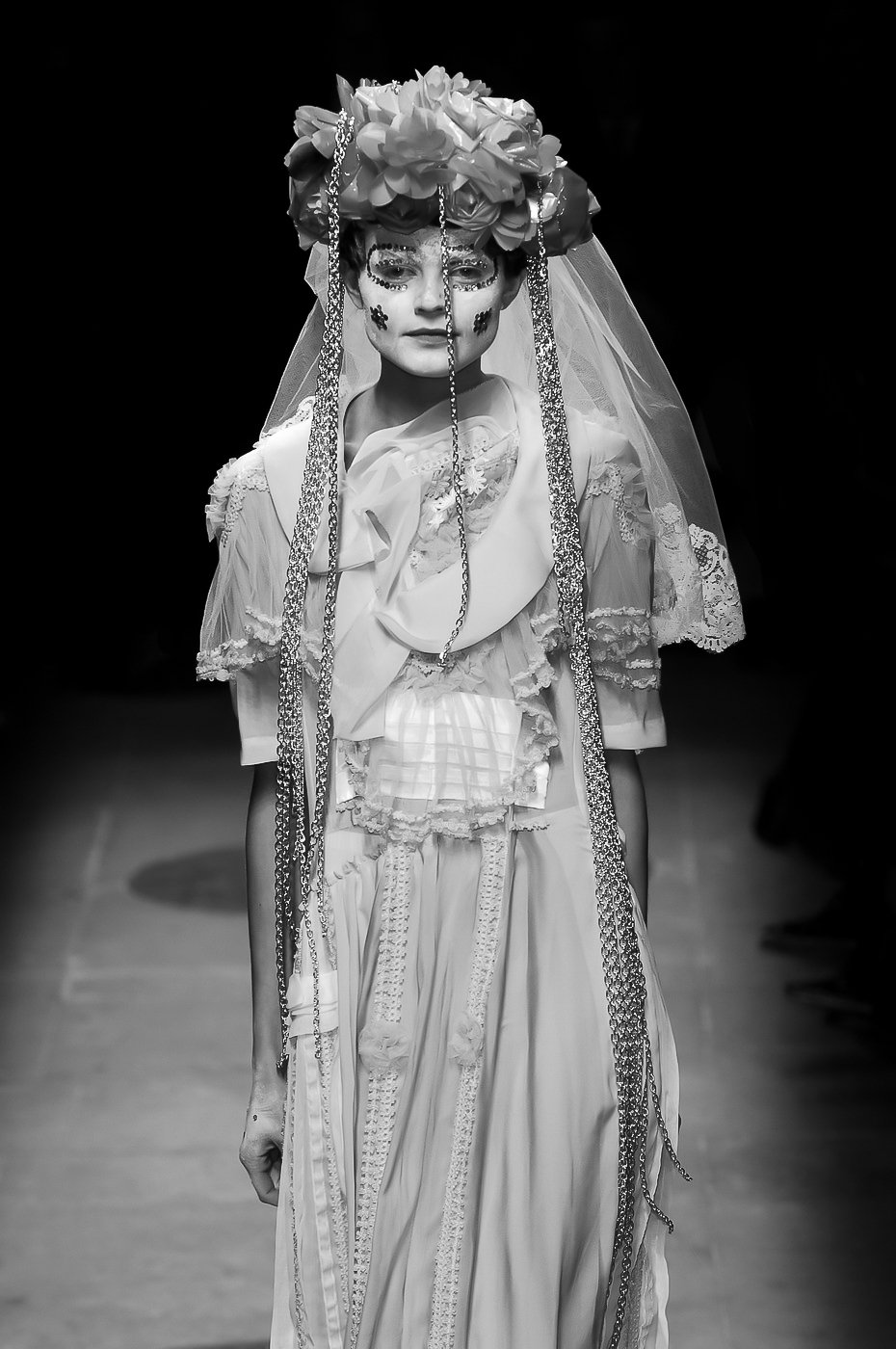BROKEN BRIDE
Katie Holmes modeling a silk gown and headpiece from Rei Kawakubo’s 2005 Broken Bride collection for Comme des Garçons • August 2005 • W Magazine • Michael Thompson
Rei Kawakubo’s 2005 Broken Bride collection and Israeli artist Sigalit Landau’s Salt Bride photographic series may have more in common than meets the eye… Symbolically, both Landau and Kawakubo were able to transform what rebels of societal constructs often deem to be a gown of mourning, into a gown of authentic celebration… Though the runways of Paris and the Dead Sea may be worlds apart, female empowerment clearly continues to be a universal ideal celebrated by artists around the globe.
One of thirteen etchings by Sigalit Landau from her portfolio Salt Wedding published by the Gottesman Etching Center • 2016
According to Kawakubo “There are many kinds of marriages. Typically, marriage is associated with being “tied up” and is conservative; this collection is anti-conservative, allows one to be free, and shows what marriage can be like.” “Comme des Garçons was an invitation to an extraordinary wedding of high concept and beautiful clothes—romantic, Victorian-flavored creations of lace and ruffle…” wrote Sarah Mower for Vogue… “The brides advanced to the strains of High Church organ music, with occasional patched-in sounds of marriage celebrations from Gypsy, Jewish, Mexican, and Caribbean weddings…”
Hanna Rovina as Leah in the Hebrew - language premiere of S. Ansky’s The Dybbuk • January 31, 1922 • Habima Theatre, Moscow
Similar in spirit, Landau’s “Salt Bride” references a traditional Yiddish play, The Dybbuk, which tells the story of a young bride possessed by an evil spirit and subsequently exorcised whilst trying to survive in a perverse financially dominated patriarchy… With the help of the Habima National Theatre, the artist created an exact replica of the traditional Hasidic dress worn by the female protagonist in S. Ansky’s 1916 play. The artist then submerged the dress several meters under the salt-rich water of the Dead Sea. She collaborated with photographer Yotam From to shoot the transformation over a period of time, as it transitioned from black to white by the lake’s alchemy. The dress was photographed in different stages that clearly show it turning from just a piece of fabric into a magic sculpture of crystals. Over time, the sea’s alchemy transformed the plain garment from a symbol associated with death and madness into the wedding dress it was always intended to be.
Israeli artist Sigalit Landau’s Salt Bride captured by photographer Yotam From • 2014 • The Dead Sea
In her own words Landau writes “Transformation and metamorphosis are my keywords. Sharing the process is sometimes part of the performative and experimental aspects of my work. Presenting traces and findings. In The Dybbuk: Between Two Worlds, a famous early-20th-century theater play, the Russian-Israeli diva Hanna Rovina performed as Lea, a young woman who is forced to marry against her will, despite being promised since childhood to another man : Hanan, her beloved soulmate. Hanan dies of grief early in the play, but his spirit possesses Lea on her wedding night. When Hanan’s voice speaks through Lea’s body, Hanna Rovina is dressed in a black dress identical to her white bridal gown. Only after a successful exorcism is performed does the dybbuk surrender to patriarchy, and Lea’s body and soul are restored. Rovina reappears on stage in her white gown. In the series of eight photographs before you, the black dress is not exchanged or discarded : it is the sea, the place, the salt crystals that bring about a gradual and natural transformation. Little by little, the black Rovina dress became a salt dress fit for a bride - a slightly different bride. A covenant of salt.”
One of thirteen etchings by Sigalit Landau from her portfolio Salt Wedding published by the Gottesman Etching Center • 2016
One of thirteen etchings by Sigalit Landau from her portfolio Salt Wedding published by the Gottesman Etching Center • 2016
Sigalit Landau’s Salt Brides on display for her solo show entitled Salt Years at the Museum der Moderne Salzburg • Salzburg • 2019
Israeli artist Sigalit Landau’s Salt Bride captured by photographer Yotam From • 2014 • The Dead Sea
Israeli artist Sigalit Landau’s Salt Bride captured by photographer Yotam From • 2014 • The Dead Sea
A scene capturing pieces from Rei Kawakubo’s 2005 Broken Bride collection for Comme des Garçons on display at The Metropolitan Museum of Art’s iconic exhibition entitled The Art of the In-Between, celebrating the prolific designer’s oeuvre • 2017 • Image courtesy of Nobu Ichimura via Blends • The Metropolitan Museum of Art, New York City
Broken Bride Printed Bag • Autumn / Winter 2005 Collection • Rei Kawakubo for Comme des Garçons • Image courtesy of 1st Dibs
Broken Bride Gown • Autumn / Winter 2005 Collection • Rei Kawakubo for Comme des Garçons • Image courtesy of Jean Tholance via Europeana • Musée des Arts Décoratifs, Paris
Natalia Vodianova modeling a silk gown from Rei Kawakubo’s 2005 Broken Bride collection for Comme des Garçons • July 1, 2005 • Vogue • Mario Testino
Israeli artist Sigalit Landau’s Salt Bride captured by photographer Yotam From • 2014 • The Dead Sea
Detail of a gown from Rei Kawakubo’s 2005 Broken Bride collection for Comme des Garçons on display at The Metropolitan Museum of Art’s iconic exhibition entitled The Art of the In-Between, celebrating the prolific designer’s oeuvre • 2017 • Image courtesy of Vin de Vie Wine of Life • The Metropolitan Museum of Art, New York City
Israeli artist Sigalit Landau’s Salt Bride captured by photographer Yotam From • 2014 • The Dead Sea
Katy Perry modeling a silk gown from Rei Kawakubo’s 2005 Broken Bride collection for Comme des Garçons • May 1, 2017 • Vogue • Mert Alaş and Marcus Piggott
Detail of a gown from Rei Kawakubo’s 2005 Broken Bride collection for Comme des Garçons on display at The Metropolitan Museum of Art’s iconic exhibition entitled The Art of the In-Between, celebrating the prolific designer’s oeuvre • 2017 • The Metropolitan Museum of Art, New York City
Israeli artist Sigalit Landau’s Salt Bride captured by photographer Yotam From • 2014 • The Dead Sea
A scene capturing pieces from Rei Kawakubo’s 2005 Broken Bride collection for Comme des Garçons on display at The Metropolitan Museum of Art’s iconic exhibition entitled The Art of the In-Between, celebrating the prolific designer’s oeuvre • 2017 • Image courtesy of Vin de Vie Wine of Life • The Metropolitan Museum of Art, New York City
Israeli artist Sigalit Landau’s Salt Bride captured by photographer Yotam From • 2014 • The Dead Sea
Keira Knightley modeling a silk dress from Rei Kawakubo’s 2005 Broken Bride collection for Comme des Garçons • December 1, 2005 • Vogue • Annie Leibovitz
Sigalit Landau’s Salt Brides on display for her solo show entitled Salt Years at the Museum der Moderne Salzburg • Salzburg • 2019
Sasha Pivovarova modeling a silk ensemble from Rei Kawakubo’s 2005 Broken Bride collection for Comme des Garçons • June 1, 2005 • Vogue • Arthur Elgort
Sigalit Landau’s Salt Brides on display at Marlborough Contemporary • London • 2016
One of thirteen etchings by Sigalit Landau from her portfolio Salt Wedding published by the Gottesman Etching Center • 2016
Natalia Vodianova modeling a silk and cotton gown from Rei Kawakubo’s 2005 Broken Bride collection for Comme des Garçons • September 1, 2005 • Vogue • Steven Klein
Israeli artist Sigalit Landau’s Salt Bride captured by photographer Yotam From • 2014 • The Dead Sea











































